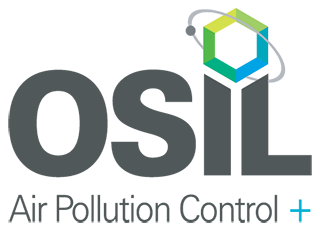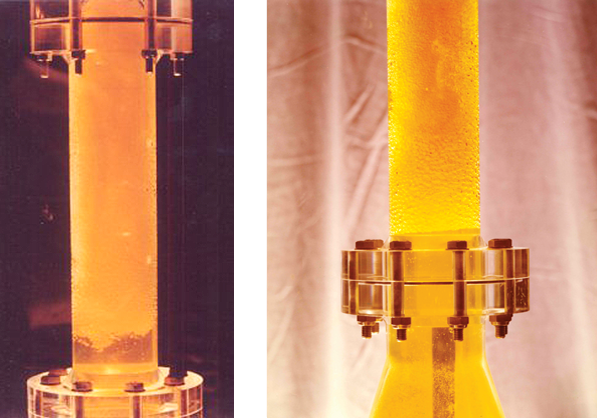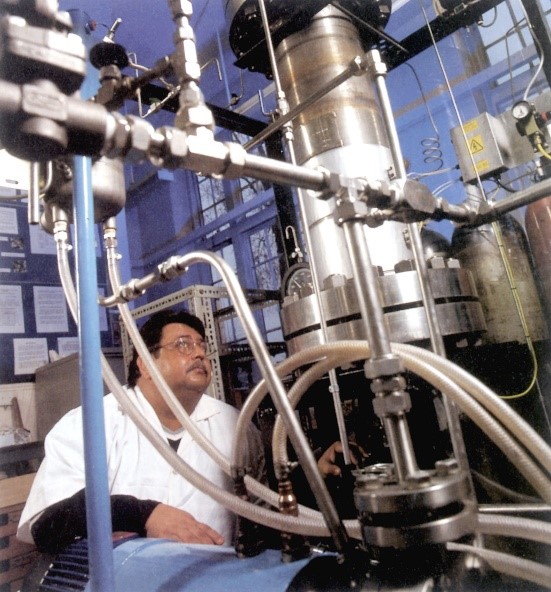We are using more renewable energy in our power grid than ever before, with wind, sunlight and hydro making up 42% of the UK’s electricity in 2020. This is a great step in reducing carbon emissions across all industries, but we cannot decarbonise our economy fully without capturing the carbon dioxide (CO2) produced by industry.
To get to net-zero carbon (where the amount of greenhouse gas produced, and the amount removed from the atmosphere, is the same) we need carbon capture.
This will require efficient scrubbing of CO2 from gaseous streams. Today, many organisations do not scrub CO2 from flue gases, or they utilise treatment methods in a variety of processes that are not efficient at CO2 capture.
The best technology for CO2 removal from gaseous streams is the Downflow Gas Contactor (DGC) which can remove CO2 with >99% efficiency.
Patented Technology for CO2 Removal
Our patented DGC technology delivers 100% gas utilisation with a small footprint and no internal moving parts. Our DGC reactor uses ABSOLV solvent, a proprietary water-based solvent that is regenerated and recycled.
The reason our technology is so useful for carbon capture is the high efficiency of gas absorption. Yet, despite capturing >99% of CO2, OSIL reactors are simple, compact and easy to fabricate, making them suitable for all facilities.
The main benefits of OSIL’s technology include:
- Recover CO2, oxygen and other gases from the absorbent
- Recycle and regenerate spent absorbent (ABSOLV)
- 100% gas utilisation
- High and accurate control of interfacial areas
- Tolerates particulates
- Lower absorbent levels required than alternative systems
- Low power consumption compared to other treatment types
- No internal moving parts
- Low engineering and fabrication costs
- Low operating costs
- Low CAPEX costs
- Simple, compact and scalable
- Easy to automate and control with minimal manual intervention
Compared to stirred tank reactors and complex multi-stage packed bed bubble columns, DGC technology is cheaper, more efficient and significantly more effective. It can also be used across a wider range of applications.
What is Downflow Gas Contactor technology?
A Downflow Gas Contactor reactor acts as a gas contactor for mass transfer of gases to liquid, separating CO2 from gaseous streams.
Put simply, the way this works is a gas and liquid absorbent are simultaneously jetted through a special entry nozzle. This causes extreme turbulence and mixing which creates a gas-liquid bubble dispersion with high gas hold-up. The scrubbed gases transfer to the liquid as it mixes, achieving >99% CO2 capture rates.
This is an alternative technology to stirred tank reactors and complex multi-stage packed bed bubble columns. The advantage DGC technology has over these is it is downflow rather than up-flow. This solves several problems:
- No back-mixing problems
- No gas pockets can form
- No foaming is possible
- Small operating volume
- Can be used at any pressure
DGC reactors are the most efficient gas-liquid contacting devices for industrial processes, and they have a wide range of applications across multiple industries.
Here’s how the technology works in more detail:
A DGC reactor consists of a cylinder upper and an inverted conical lower section when treating pure gases. A gas and liquid stream is introduced at the top through a specially designed injector entry (SDI). The high velocity of the liquid creates intense turbulence and energy, producing an agitated dispersion with a high interfacial area.
The small operating volume of the DCG together with the high interfacial area and extreme turbulence caused by the incoming jet liquid induces mixing and mass transfer of gases (CO2) to liquid. This forms a gas-liquid bubble dispersion. This expands down the column where larger bubbles rise again and are broken up again.
Our DGC systems use ABSOLV solvent, a water-based solvent that can capture both CO2 and H2S from biogas and any other air gas streams.
Downflow Gas Contactor applications
DGC technology will play an essential future role in decarbonisation through carbon capture. If we are to achieve net-zero carbon, then we need to tackle carbon emissions at the source. DGC technology enables this with outstanding efficiency.
Here’s a rundown of the main applications for DGC technology:
- Carbon capture: CO2 and mixed gases
- Biogas upgrading: Upgrading of biogas by removing CO2 and H2
- Effluent treatment: Reducing oxygen or ozone in liquid wastes
- Chemical reactions: Hydrogenation and oxidation processes
- Air flotation: Water treatment to separate solids with microbubbles
Let’s take a closer look at the two primary applications for Downflow Gas Contactors (carbon capture, biogas upgrading):
DGC for carbon capture
The CO2 capture efficiency of DGC technology has been validated and is of significant interest to the energy market and industrial firms.
Conventional scrubbers are much larger than DGC reactors with significantly higher CAPEX costs. The gas utilisation of scrubbers/packed towers also only reaches as high as 65%, while OSIL’s DGC technology achieves 100% – a significant improvement.
A DGC can be operated at low or high pressures and ambient temperature, so there are no special operating requirements, simplifying its operation.
OSIL’s Downflow Gas Contactor technology captures >99% CO2 from gaseous streams including flue gases. This allows a significant portion of carbon to be captured from industrial processes, such as manufacturing, water treatment and energy generation, and it does this with low disruptive power consumption.
DGC for biogas upgrading
OSIL’s Downflow Gas Contactor technology uses ABSOLV which can capture and separate both CO2 and H2S from biogas in a single stage.
This ‘single stage’ is an important differentiation from other technologies which remove CO2 and H2S sequentially i.e. as part of a multi-stage treatment process.
DGC technology consumes less power than alternative technologies and also has the advantage of enabling small and large scale carbon capture. It’s effective even for a small plant of 5 m3/hr and it can be scaled cost-effectively. Recovery of absorbed CO2 is possible and ABSOLV can be recycled to reduce material waste.
Our systems improve the quality of biogas and enhance the calorific value. The low CAPEX and OPEX costs result in significant savings versus other treatments.
Recovery and utilisation of captured CO2
Carbon capture with Downflow Gas Contactors is necessary if our economy is to achieve net-zero carbon. Something has to be done about the CO2 from industrial processes and DGC reactors offer an ideal solution today.
Importantly, Downflow Gas Contactors enable post-combustion capture of CO2 in an economically feasible manner. The technology uses less energy than other systems and it achieves capture rates of >99%. It can also scrub oxygen, carbon dioxide and ammonia from water, so it can be used to refine water treatment processes.
Captured CO2 can be stored indefinitely to isolate it from the atmosphere, or it can be used in industry. Use cases for captured CO2 include manufacturing synthetic fuels, plastics, polymers, fertilisers and building materials. It can also be used directly in carbonated drinks, enhanced oil recovery and agricultural processes.
Take a step closer to net-zero carbon today
OSIL can advise towards an Asset Light Approach with Downflow Gas Contactors to maximise your CAPEX budget. You can also benefit from our expert advice for CO2 removal so that your efforts achieve the best possible results.
Net-zero carbon is achievable for most industrial companies. Downflow Gas Contactor technology is suitable for capturing and separating CO2 and H2S from gaseous streams. Our systems are highly efficient, scalable and low-power.
Download our Carbon Capture Leaflet here
For more information, call us on 01543 506855 or email sales@osiltd.com.



